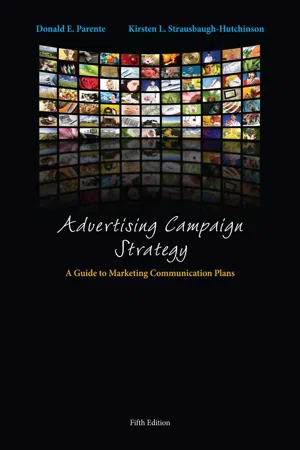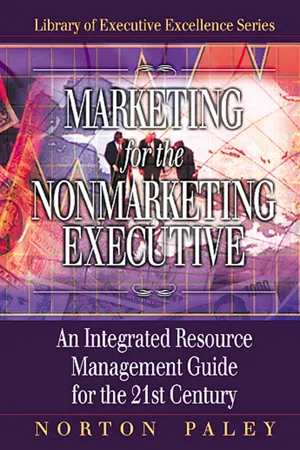Marketing
Marketing Strategy
A marketing strategy is a plan of action designed to promote and sell a product or service. It involves identifying target markets, understanding customer needs, and creating a unique value proposition to differentiate the offering from competitors. The strategy encompasses various elements such as pricing, distribution, and promotional tactics to achieve the organization's marketing objectives.
Written by Perlego with AI-assistance
Related key terms
1 of 5
12 Key excerpts on "Marketing Strategy"
- eBook - PDF
- Daniel Padgett, Andrew Loos(Authors)
- 2023(Publication Date)
- Wiley(Publisher)
These goal-driven plans of action are the key to successful businesses. While some would say all business involves strategy, marketing is one area of the business where strategy is not only prominent but also critical to success, not just for the marketing department but also for the whole company. Since marketing deals directly with customers, and is in charge of managing the exchanges with customers, a failure by marketing to encourage profitable exchanges with customers means failure for the entire company. As a result, marketers are constantly engaged in strategy formulation. Formally, we define Marketing Strategy as the managerial process of creating and maintaining plans of action that facilitate exchanges that have value to both the customer and the company in an evolving mar- ket environment. In basic terms, Marketing Strategy is goal-driven action plans that get customers to do what the company wants. Marketing strat- egy is required to get customers to purchase a bottle of water for $1.75 from a drink machine when they could get a drink of water free from the water fountain 6 feet away. As you may guess, this is not an easy task and requires a structured approach to be effective. Executing a successful Marketing Strategy involves three major steps (see Figure 2.1). First, the manager sets specific marketing goals and determines a plan of action to achieve the goals. Second, the plan is Listen to Author Podcast strategy Plan of action used to achieve a goal. Marketing Strategy The managerial process of creating and maintaining plans of action that facilitate exchanges that have value to both the customer and the company in an evolving market environment. Plan • Goals • Short • Long • Actions • Budget • Timeline Implement • Tools • Tactics Evaluate • Measure • Compare to goals/expected outcomes/ objectives • Feedback to. . . • modify plan • modify implementation 1 2 3 FIGURE 2.1 A Successful Marketing Strategy Involves Planning, Implementing, and Evaluating. - eBook - PDF
Management
A Concise Introduction
- Richard Pettinger(Author)
- 2012(Publication Date)
- Red Globe Press(Publisher)
● Strategy must always be monitored, reviewed and evaluated for effectiveness. Where problems are likely to arise, or where present position is becoming unsustainable, strategic, as well as operational, decisions need to be taken. ● Strategy is a continuous process requiring attention to the long term as well as to immediate results. The strategy process is a critical aspect of developing opportunities and activities for the future, as well as ensuring what is done at present remains effective. Further reading Campbell, D., Edgar, D. and Stonehouse, G. (2011) Business Strategy: An Introduction. Palgrave Macmillan. Johnson, G., Scholes, K. and Whittington, R. (2009) Exploring Corporate Strategy. PHI. Pettinger, R. (2004) Contemporary Strategic Management. Palgrave Macmillan. Porter, M. (1980) Competitive Strategy. Free Press. Porter, M. (1985) Competitive Advantage. Free Press. Whittington, R. (2009) What is Strategy and Does it Matter. Thomson. 219 219 219 In this chapter ● the nature of marketing and its position in developing effective business and organizational activities ● knowing and understanding the components of effective marketing strategies, processes and activities ● managing the development of products and services ● identifying, managing and developing customer bases Introduction The purpose of this chapter is to introduce and illustrate the priorities and principles required for a full understanding of marketing. Marketing is the competitive process by which goods and services are offered for consumption at a profit. Marketing combines product and service substance with effective presentation, convenience, value and acceptability to engage the interest and commitment of customers, consumers and clients, and the public at large. Marketing processes and activities are normally classified as follows. - Bonita M. Kolb(Author)
- 2016(Publication Date)
- Routledge(Publisher)
components , product, price, distribution, and promotion, to fulfill both the mission of the organization and the needs of the customer.- The process of writing a marketing plan will force the organization to answer difficult questions. An organization may have many ideas for future action, but as resources are limited, the plan will force the organization to make choices. Goals, objectives, and tactics that provide a roadmap of how to achieve these choices and how success can be measured will then be developed.
The relationship between strategic planning and marketing
New definitions for strategy and marketingThe world is much less static than in the past resulting in a new definition of strategy. Because consumers’ wants and needs constantly change as they access the continual stream of online information, the strategic planning process must be dynamic with constant revision as the plan is being implemented. As each action takes place, consumer feedback is assessed to see if changes must be made before the next step is taken.Strategy old definition : “Create unique and sustainable value by differentiating goods and services.”Strategy new definition : “Find unique, valuable, and sustainable ways of linking together a firm’s knowledge and skills with customers that will benefit from them.”How consumers use products has also changed. In the past, a company would provide instructions on product use and expect them to be followed. Now the consumer decides how to use the product and then shares this knowledge online with others. As a result, the company must provide information that suggests how the product can be used to meet the consumer’s needs but must still understand that each customer is unique and may use the product differently.- eBook - PDF
- O. C. Ferrell, Michael Hartline, O. C. Ferrell, Michael Hartline, Bryan Hochstein(Authors)
- 2021(Publication Date)
- Cengage Learning EMEA(Publisher)
Marketing Strategy This section of the marketing plan outlines how the firm will achieve its marketing objectives. In Chapter 1, we said that marketing strategies involve selecting and ana- lyzing target markets and creating and maintaining an appropriate marketing program (product, distribution, promotion, and price) to satisfy the needs of those target markets. It is at this level where the firm will detail how it will gain a competitive advantage by doing something better than the competition: Its products must be of higher quality than competitive offerings, its prices must be consistent with the level of quality (value), its distribution methods must be as efficient as possible, and its promotions must be more effective in communicating with target customers. It is also important that the firm attempts to make these advantages sustainable. Thus, in its broad- est sense, Marketing Strategy refers to how the firm will manage its relationships with customers in a manner that gives it an advantage over the competition. Marketing Implementation The implementation section of the marketing plan describes how the marketing program will be executed. This section of the marketing plan answers several questions with respect to the marketing strategies outlined in the preceding section: 1. What specific marketing activities will be undertaken? 2. How will these activities be performed? 3. When will these activities be performed? 4. Who is responsible for the completion of these activities? 5. How will the completion of planned activities be monitored? 6. How much will these activities cost? Without a good plan for implementation, the success of the Marketing Strategy is seriously jeopardized. For this reason, the implementation phase of the marketing plan is just as important as the Marketing Strategy phase. You should remember, too, that implementation hinges on gain- ing the support of employees: Employees implement marketing strategies, not organizations. - eBook - PDF
- Dawn Iacobucci(Author)
- 2021(Publication Date)
- Cengage Learning EMEA(Publisher)
285 Marketing Strategy Strategy can mean a lot of things, so we’ll begin by discussing business and marketing goals, and then we will look at several approaches to thinking about Marketing Strategy. We’ll assess our company’s current standing and what it will take to achieve our goals. Then we’ll consider measures to evaluate the extent to which we’ve been successful at doing so. 16-1 Types of Business and Marketing Goals 16 Learning Objectives After you have finished this chapter, you should be able to: LO 16-1 Describe how marketing goals contribute to business strategies LO 16-2 Discuss classic and standard frameworks for thinking about strategic choices LO 16-3 Develop plans to begin to execute a Marketing Strategy LO 16-4 Identify the various metrics used to assess the strategy’s effectiveness 5Cs Customer Company Context Collaborators Competitors STP Segmentation Targeting Positioning 4Ps Product Price Place Promotion M anagerial Checklist • What types of business and marketing goals are there? • What is Marketing Strategy? • How do we “do” strategy? • What are the key marketing metrics we want on our dashboard? DEFINITIONS FROM DICTIONARY.COM ● ● Goal : The purpose toward which an endeavor is directed; an objective ● ● Objective : Something that one’s efforts or actions are intended to attain or accomplish; purpose; goal; target ● ● Strategy : A plan, method, or series of maneuvers for obtaining a specific goal or result Copyright 2022 Cengage Learning. All Rights Reserved. May not be copied, scanned, or duplicated, in whole or in part. Due to electronic rights, some third party content may be suppressed from the eBook and/or eChapter(s). Editorial review has deemed that any suppressed content does not materially affect the overall learning experience. Cengage Learning reserves the right to remove additional content at any time if subsequent rights restrictions require it. 286 Let’s begin by thinking about business very simply. - eBook - PDF
- Daniel Padgett, Andrew Loos(Authors)
- 2021(Publication Date)
- Wiley(Publisher)
Marketing strat- egy at the organizational level involves determining which business opportunities the organization would like to pursue and allocating appropriate resources to capitalize on these opportunities. • The typical organizational marketing structure depends to some extent on the size of the company, but in general there are three lev- els: (1) corporate, (2) strategic business unit (SBU) or business level, and (3) department level. Except in very small companies, marketing is usually a separate department within the company or business unit. • A mission statement is a definition of the firm’s business focus that provides direction for the company. • The most successful companies offer something others don’t, which suggests that another important element in the marketing plan is the description of what sets the company apart from its competition. An advantage over competitors gained by offering greater customer value, either by having lower prices or providing more benefits that justify higher prices, is referred to as a competitive advantage. 2.2 Marketing Planning • Before a marketer decides what to do, she or he must under- stand the situation in great detail, as the situation dictates what is possible and sets constraints on marketing activities. The most common approach for assessing the situation is to use a SWOT analysis. A SWOT analysis involves identifying internal strengths (S) and weaknesses (W) and external opportunities (O) and threats (T). Discussion Questions 37 • After the situation analysis and opportunity assessment, the next component of the marketing plan is to set marketing objectives. Generally, marketing objectives state what is to be accomplished through the marketing efforts. • Once a company decides on objectives, it develops a marketing plan—a written document that guides marketing activities. - eBook - PDF
- James Burrow(Author)
- 2020(Publication Date)
- Cengage Learning EMEA(Publisher)
The goals are followed by a full description of the target market, the marketing mix, and a specific positioning statement (Figure 9-4). Determine Goals and Outcomes The Marketing Strategy is based on a spe- cific statement of the goals the company plans to achieve or the expected outcomes of the marketing efforts. The company determines whether the Marketing Strategy is effective based on whether the goals have been met. Marketing goals include such things as increasing sales or profits for cer- tain products, increasing the market share for a product in a particular geographic area or target market, increasing the effec- tiveness of particular parts of the marketing mix such as distribution or customer ser- vice, or other specific results. Define a Target Market The Marketing Strategy will clearly identify the target market to be served. The target market will be defined completely so it can be located, so the company’s employees will understand the market’s characteristics and the target customers’ needs and wants, DEVELOP A Marketing Strategy Determine goals and outcomes States the goals the company plans to achieve or the expected outcomes of the marketing efforts Define target market Allows the target market to be located and the company employees to understand the market characteristics and customer’s needs and wants. Specify the marketing mix Describes each mix element in marketing the product. Develop a positioning statement Describes the unique qualities of the marketing mix that make the product satisfying to the target market and that differentiate it from the competition FIGURE 9-4 Follow these four steps in developing the Marketing Strategy for a product. Copyright 2021 Cengage Learning. All Rights Reserved. May not be copied, scanned, or duplicated, in whole or in part. Due to electronic rights, some third party content may be suppressed from the eBook and/or eChapter(s). - eBook - PDF
Advertising Campaign Strategy
A Guide to Marketing Communication Plans
- Donald Parente, Kirsten Strausbaugh-Hutchinson(Authors)
- 2014(Publication Date)
- Cengage Learning EMEA(Publisher)
It is general in nature and takes place over time. A good strategy is flexible and anticipates consumer responses and competitive reactions. This chapter has been written in part by JoAnn Anderson, brand and multiplatform research analyst at CNN in New York City. JoAnn has a background in television advertising, social media, and entertainment marketing. Currently, her role encompasses strategizing in the digital and social spheres, where her perpetual interest in how brands innovate and evolve with their fans serves her well. 147 Copyright 2015 Cengage Learning. All Rights Reserved. May not be copied, scanned, or duplicated, in whole or in part. Due to electronic rights, some third party content may be suppressed from the eBook and/or eChapter(s). Editorial review has deemed that any suppressed content does not materially affect the overall learning experience. Cengage Learning reserves the right to remove additional content at any time if subsequent rights restrictions require it. It was noted in the previous chapter that there is a distinct difference between marketing and communication objectives. And it was made clear that a comprehensive campaign requires both. It should be no surprise then that you need to outline both a strong Marketing Strategy and a solid communication strategy if you ’ re going to reach your goals. Marketing Strategy: Recall that marketing objectives originate with the client. They often revolve around sales, business growth, profits, traffic, transactions, bookings, gains and losses, and so forth. As such, they require a Marketing Strategy focused on the careful management of the 4P ’ s of marketing: product, price, place, and promotion. To achieve their goals, companies can modify their production process and materials, control vol-ume, and improve or expand their product offerings. They can manipulate pricing structure to offset costs, increase profit margins, as well as to attract or deter particular consumer groups. - eBook - PDF
Applied Marketing
Connecting Classrooms to Careers
- Daniel Padgett, Andrew Loos(Authors)
- 2019(Publication Date)
- Wiley(Publisher)
A marketing plan is a living document in the sense that it is intended as a guide for action, but should be open to modification when necessary. If you are traveling and your primary route is blocked due to road construction, you need to find an alternate route to get to your destination. A marketing plan is like a map and a good marketing department knows that sometimes diver- sions and rerouting are necessary. The important outcome is to arrive at the destination in the most effective way possible. 2.3 Concept Check 1. How is a marketing plan implemented? 2. What is meant by having safeguards as part of an implementation strategy? 3. Describe a marketing dashboard. When and why are they used? 4. Explain the definition and purpose of a marketing audit. Chapter Summary 2.1 Marketing Strategy and Differentiation • Marketing Strategy is the managerial process of creating and maintaining exchanges that have value to both the customer and the company in an evolving market environment. Marketing strat- egy at the organizational level involves determining which busi- ness opportunities the organization would like to pursue and allo- cating appropriate resources to capitalize on these opportunities. • The typical organizational marketing structure depends to some extent on the size of the company, but in general there are three levels: (1) corporate, (2) strategic business unit (SBU) or business level, and (3) department level. Except in very small companies, marketing is usually a separate department within the company or business unit. • A mission statement is a definition of the firm’s business focus that provides direction for the company. • The most successful companies offer something others don’t, which suggests that another important element in the marketing plan is the description of what sets the company apart from its competition. - Bonita Kolb, Bonita M. Kolb(Authors)
- 2020(Publication Date)
- Routledge(Publisher)
Strategic planning is inherently uncertain and dynamic as customers and resources are constantly changing. The best an organization can do is to evaluate the possibilities for future consumer needs and how it might provide customers with products that meet these needs. Social media has now provided new channels for obtaining this information (Breakenridge 2018). Analyzing consumer comments on social media can help the organization better understand consumer desires. Social media also allows the organization to more easily keep abreast of competitor strategies so that they can counter any threats to sells of their own products. Consumer feedback and competitor changes must be incorporated into the organization’s Marketing Strategy.Marketing Strategy involves more than just knowing the components of product, price, distribution, and promotion; it also involves understanding a process of planning the use of resources. No strategy can be accomplished without a plan on how to use the resources of time, people, and money. The marketing plan starts with writing the mission, vision, and values of the organization. The next step is to analyze the organization’s internal resources such as people, money, and culture. Once this is done, the external environment is scanned to analyze how the economic, socio-cultural, technological, and demographic forces outside of the organization’s control will affect the ability to reach its strategic goals.Mission, vision, and values—telling everyone who you are and what you believe
Marketing is a strategic process that starts with the mission, vision, and values of the organization. People who do not understand business believe that people in a company will do anything to make money. First, this is untrue because there are legal protections for the consumer. Second, people are too knowledgeable to purchase a product that does not provide the benefits they desire, and if they make a mistake and do so, they will go online to warn everyone else to not purchase the product. Finally, most people have ethical values that they incorporate into all aspects of their daily lives, including their businesses.- eBook - PDF
- Malcolm McDonald, Ailsa Kolsaker(Authors)
- 2017(Publication Date)
- Red Globe Press(Publisher)
For example, it would be no good receiving plans from two product managers, one of whom believed the economy was about going into decline by 2 per cent, while the other believed the economy was about to grow by 10 per cent. Assumptions should be few in number, and if a plan is robust – that is, possible irrespective of any assumption made – then so much the better. MARKETING OBJECTIVES AND STRATEGIES The next step in marketing planning is the writing of marketing objectives and strategies, the key step in the whole process: ■ Objectives are what you want to achieve; and ■ Strategies are how you plan to achieve your objectives. There can be objectives and strategies at all levels in marketing. For exam-ple, there can be advertising objectives and strategies and pricing objectives and strategies. However, it is important to remember that marketing objec-tives are about products and markets only . Common sense will confirm that it is only by selling something to someone that the company’s financial goals can be achieved, and that advertising, pricing and service levels are the means (or strategies) by which we might succeed in doing this. Thus pricing objectives, sales-promotion objectives and advertising objectives should not be confused with marketing objectives. In other words, we can say that marketing objectives are about one or more of the following: ■ Existing products in existing markets; ■ New products for existing markets; ■ Existing products for new markets; and ■ New products for new markets. 121 SWOT analysis 1 SBU description here, describe the market for which the SWOT is being done. 5 Opportunities/threats what are the few key things outside your direct control that have had, and will continue to have, an impact on your business? 2 Critical success factors what are the few key things from the customer’s point of view, that any competitor has to do right to succeed? 3 Weighting how important is each of these CSFs? Score out of 100. - eBook - PDF
Marketing for the Nonmarketing Executive
An Integrated Resource Management Guide for the 21st Century
- Norton Paley(Author)
- 2000(Publication Date)
- CRC Press(Publisher)
1 185 The Strategic Marketing Plan: How to Develop Business-Building Strategies and Action Plans INTRODUCTION This is the point where you put it all together into a plan: the foundation concepts and practices related to marketing management, customer relationship management, and market intelligence. Here is where you combine the overall attributes associated with operating a market-driven organization, discussed in the preceding chapters, into one organized document that drives your business decisions. Above all, here is the docu-ment that highlights your strategies and tactics. The document permits an organized and rational look as you: • Appraise customer needs. • Decide on new product development projects. • Analyze the business environment in which you operate. • Identify your organization’s core competencies. • Evaluate current and potential market segments. • Assess the impact of competition on your company’s market position. How important is it to add a planning structure to those diverse issues? What are the tangible outcomes of the labor-intensive planning process? In part, the answers are given in PricewaterhouseCoopers’ 1998 Trendsetter Barometer Survey, which points out that two thirds of rapid-growth firms have written business plans. Further, the survey reveals that over a two-year period, firms with written plans grow faster, achieve a higher proportion of revenues from new products and services, and enable CEOs to manage more critical business functions than those firms whose plans are unwritten. Additionally, growth firms with a written business plan have increased their revenues 69% faster over a 5-year period than those without a written plan. The planning format discussed here is the Strategic Marketing Plan (SMP) . It evolved into its present format in the 1990s by combining the best elements of the 9 long-term strategic plan with the traditional one-year marketing plan that has served marketing managers for over four decades.
Index pages curate the most relevant extracts from our library of academic textbooks. They’ve been created using an in-house natural language model (NLM), each adding context and meaning to key research topics.











